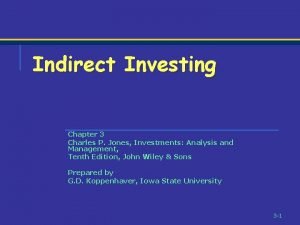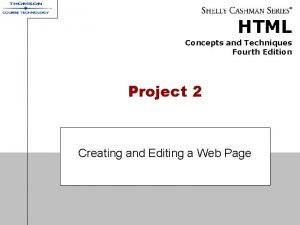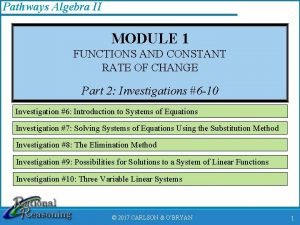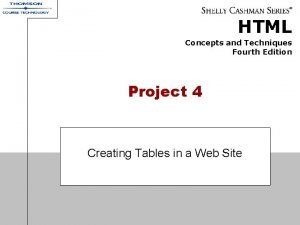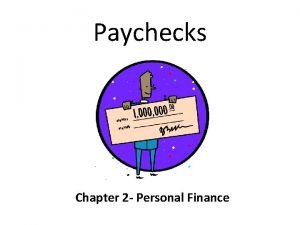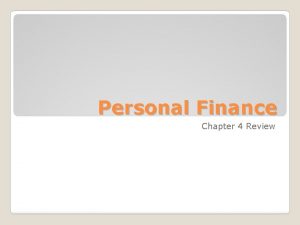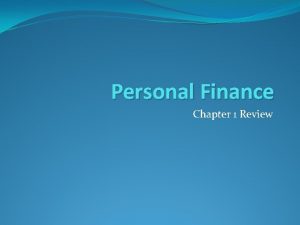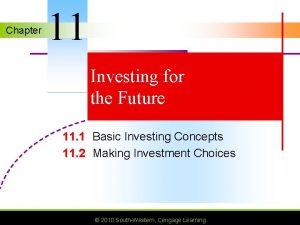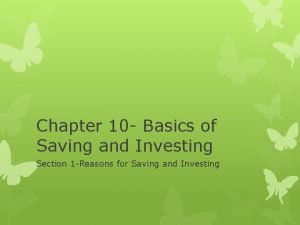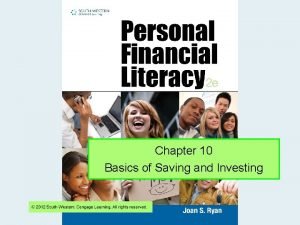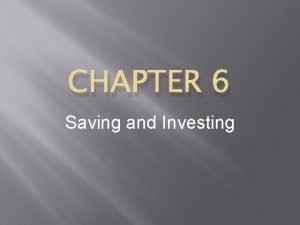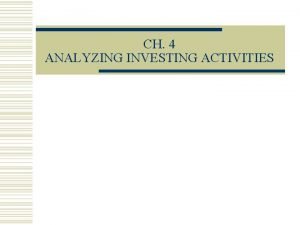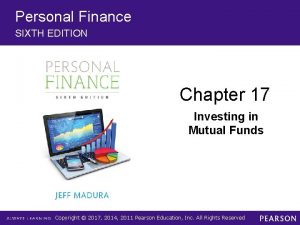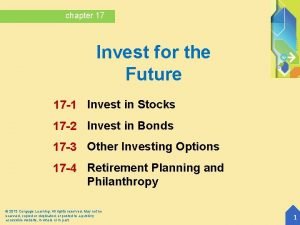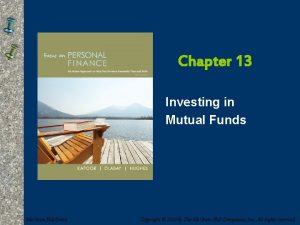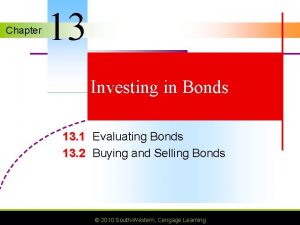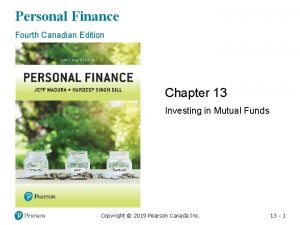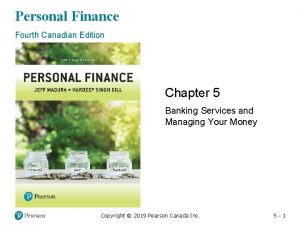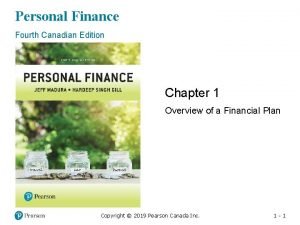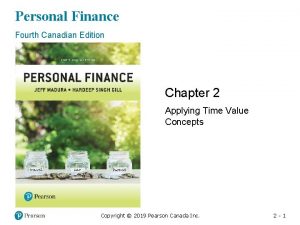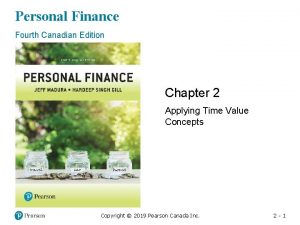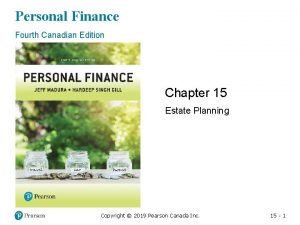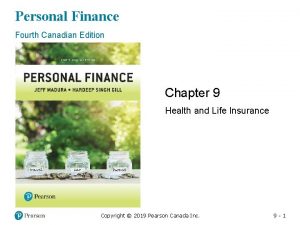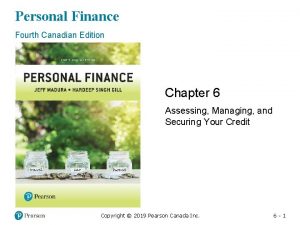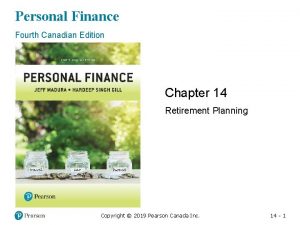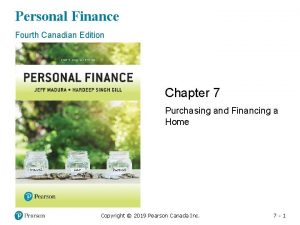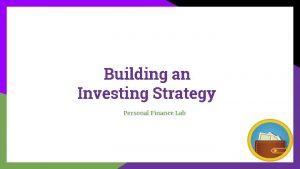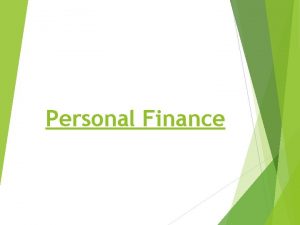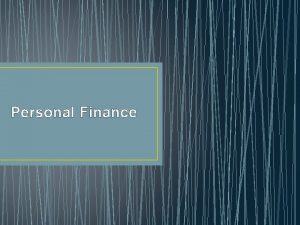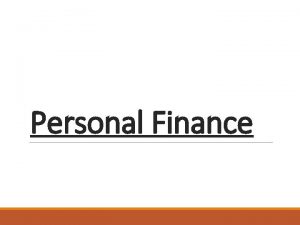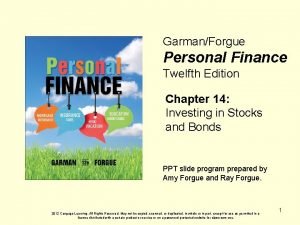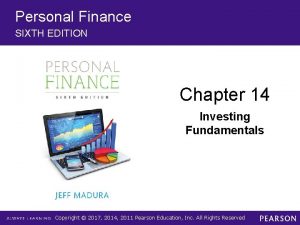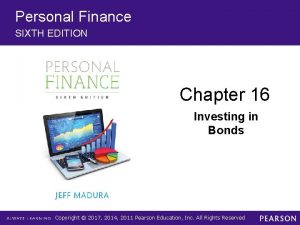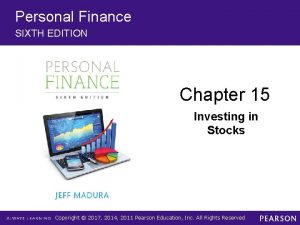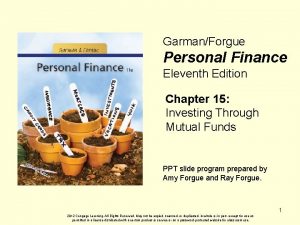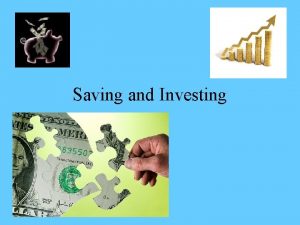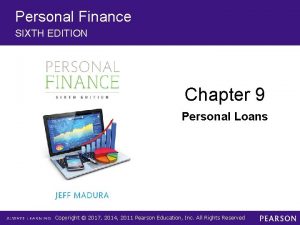Personal Finance Fourth Canadian Edition Chapter 12 Investing





































- Slides: 37

Personal Finance Fourth Canadian Edition Chapter 12 Investing In Bonds Copyright © 2019 Pearson Canada Inc. 12 - 1

Chapter Objectives • Identify the different types of bonds • Explain what affects the return from investing in a bond • Describe why some bonds are risky • Identify common bond investment strategies Copyright © 2019 Pearson Canada Inc. 12 - 2

Background on Bonds (1 of 3) • Bonds: long-term debt securities issued by government agencies or corporations that are collateralized by assets (more favourable than bank deposits, periodic interest income) • Debentures: long-term debt securities issued by corporations that are secured only by the corporation’s promise to pay (riskier than bonds) Copyright © 2019 Pearson Canada Inc. 12 - 3

Background on Bonds (2 of 3) • Par value: for a bond, its face value, or the amount returned to the investor at the maturity date when the bond is due • Term to maturity: the date at which a bond will expire and the par value of the bond, along with any remaining coupon payments, is to be paid back to the bondholder • Bonds maturities may vary between 1 and 30 years Copyright © 2019 Pearson Canada Inc. 12 - 4

Background on Bonds (3 of 3) • Investors provide the issuers of bonds with funds • Issuers are obligated to make interest payments and to pay the par value at maturity • Coupon (interest) payments are normally paid semi-annually • Some bonds are issued at a price below par value (offering additional return) Copyright © 2019 Pearson Canada Inc. 12 - 5

Bond Characteristics (1 of 3) • Call feature (allows the issuer to repurchase the bond from the investor before maturity) – Offer a slightly higher return than similar bonds without a call feature Five years ago, Cieplak Inc. issued $10 million of 15 -year callable bonds with a coupon rate of 9 percent. The corporation also created a sinking fund provision that would require them to set aside $500 000 every year in order to retire this amount of debt. As a result, Cieplak Inc. has retired $2 million worth of bonds in the past four years. In addition, interest rates have declined since then. Today, Cieplak could issue new bonds at a rate of 7 percent. It decides to retire the remaining bonds by repurchasing them from investors and to issue new bonds at a 7 percent coupon rate. By calling the old bonds, Cieplak has reduced its cost of financing. However, call features do not usually allow the company to call outstanding bonds at one time. In addition, there is usually a call premium to compensate investors for the call. Copyright © 2019 Pearson Canada Inc. 12 - 6

Bond Characteristics (2 of 3) • Sinking fund (money set aside by a corporation or government to repurchase a set amount of bonds in a set period of time, like a mandatory call feature) • Convertible bond (can be converted into a stated number of shares of the issuer’s stock at a specified price) • Extendible bond • Put feature (redeem at face value before it matures) Copyright © 2019 Pearson Canada Inc. 12 - 7

Bond Characteristics (3 of 3) • Yield to maturity (annualized return if held until maturity) – If a bond sells at par value, its yield to maturity equals the coupon rate • Discount (bond trading below its par value) – If a bond sells below par value, its yield to maturity would exceed the coupon rate • Premium (bond trading above its par value) – If a bond sells above par value, its yield to maturity would be less than the coupon rate Copyright © 2019 Pearson Canada Inc. 12 - 8

Bond TVM Example Copyright © 2019 Pearson Canada Inc. 12 - 9

Bonds Trading in the Secondary Market • Investors can sell their bonds to other investors before the bonds reach maturity • Bond prices change in response to interest rate movements and other factors • Investors buy or sell bonds from a brokerage firm’ bond inventory Copyright © 2019 Pearson Canada Inc. 12 - 10

Term Structure of Interest Rates • a graph that shows the relationship between bond yield to maturity and time to maturity – Helps manage bond portfolios – Resulting curve is known as a yield curve – Shape of the yield curve reflects the market’s sentiment about the direction for interest rates over time – Yield curve shapes include normal, steep, inverted, and flat Copyright © 2019 Pearson Canada Inc. 12 - 11

Term Structure Gov’t of Canada Yields (normal yield curve) Copyright © 2019 Pearson Canada Inc. 12 - 12

Term Structure of Interest Rates Theories • Liquidity preference theory: investors require a premium for investing in longer-term bonds • Pure expectations theory: the shape of the yield curve is a reflection of the market’s expectation for future interest rate movements • Market segmentation theory: the shape of the yield curve is determined by the supply and demand of bonds for various market players in different segments of the yield curve Copyright © 2019 Pearson Canada Inc. 12 - 13

Types of Bonds • Government of Canada Bonds (no default risk, 1 -30 yr. term, easily sold, ‘marketable bonds’) • Federal Crown Corporation Bonds (no default risk, 2 -10 yr. term, easily sold, EDC, CMHC, FCC, BDBC) • Provincial Bonds (default risk varies, 1 -30 yr. term, easily sold) • Municipal Bonds (default risk very low, terms vary, uncommon) • Corporate Bonds (default risk varies, terms vary) Copyright © 2019 Pearson Canada Inc. 12 - 14

Corporate Bond Quotations Exhibit 12. 2 An Example of a Corporate Bond Quotation Company Enbridge Pipeline Coupon Maturity Price Yield 6. 55% November 17, 2027 127. 06 3. 64% Source: An in-depth look at Canadian and U. S. market data, retreived from http: //www. globeinvestor. com/servlet/Page/document/v 5/data/bonds? type=corp Copyright © 2019 Pearson Canada Inc. 12 - 15

Short-Term Debt Securities • T-Bills: short-term debt securities issued by the Canadian and provincial governments and sold at a discount – Do not make coupon payments • Banker’s acceptances (BAs): short-term debt securities issued by large firms that are guaranteed by a bank Copyright © 2019 Pearson Canada Inc. 12 - 16

Commercial Paper • a short-term debt security issued by large firms that is guaranteed by the issuing firm • Yield to maturity will be lowest for T-bills • Commercial paper will have the highest yield to maturity • Although not paid, interest must be recognized every year • T-bills, BAs, and commercial paper are important parts of an MMF’s investment portfolio Copyright © 2019 Pearson Canada Inc. 12 - 17

Canada Savings Bonds (CSBs) • ten-year debt securities issued by the Canadian government • Fully guaranteed • Can be purchased as a simple interest bond or a compound interest bond • Can be redeemed at any time before maturity • Discontinued as of November 2017 (as are Canada Premium Bonds or CPBs) Copyright © 2019 Pearson Canada Inc. 12 - 18

Mortgage-Backed Securities (MBSs) • A pool of CMHC-insured residential mortgages that are issued by banks and other financial institutions • A guaranteed flow-through investment • Attractive to investors seeking income • Can be sold in the secondary market • Issued with a term to maturity of between 1 and 10 years • Subject to prepayment risk Copyright © 2019 Pearson Canada Inc. 12 - 19

Strip Bonds • Long-term debt securities issued by the Government of Canada (and some provinces) that do not offer coupon payments • Can be sold at a very deep discount • Although not paid, interest must be recognized every year (and tax must be paid on it) • Very safe investment in terms of default risk and can be sold in the secondary market • Very high interest rate risk Copyright © 2019 Pearson Canada Inc. 12 - 20

Real Return Bonds • Long-term debt securities issued by the Government of Canada that protect you from inflation risk • All other bonds are exposed to inflation risk • The par value of the bond is adjusted for changes in the inflation rate • Coupon payments will increase with each increase in the face value Copyright © 2019 Pearson Canada Inc. 12 - 21

Real Return Bond Example You buy a $1000 real return bond that has a coupon rate of 5 percent. Assume that inflation increases by 2 percent in the next six months. Interest is paid semiannually. The bond’s par value and coupon payment will increase as follows: Inflation-adjusted par value = $1000 × (1 + 0. 02) = $1020 Inflation-adjusted semi-annual coupon payment = $1020 × (0. 05 ÷ 2) = $25. 50 • Actual amount of interest paid during the year will be based on the initial par value • At maturity, the accumulated difference between the inflation-adjusted coupon payment and the regular coupon payment will be paid to the investor, along with the inflation-adjusted par value • Issued with a term to maturity of between 1 and 30 years Copyright © 2019 Pearson Canada Inc. 12 - 22

Return from Investing in Bonds • Return depends on the price at the time you sell the bond • Impact of interest rate movements – If the bond coupon rate is less than the current coupon rate on similar bonds, you must sell the bond at a discount – If the bond coupon rate is more than the current coupon rate on similar bonds, you can sell the bond for a premium – Interest rate movements and bond prices are inversely related Copyright © 2019 Pearson Canada Inc. 12 - 23

Tax Implications of Investing in Bonds • Interest income is taxed as ordinary income • Tax on interest income must be paid in the year it is earned • Selling bonds at a price different than what you paid for them results in a capital gain (or loss) You purchase $10 000 face value newly issued bonds for $9700. The bonds mature in 10 years and pay a coupon rate of 8 percent, or $800 (computed as 0. 08 × $10 000) per year. The coupon payments are made every six months, so each payment is $400. Exhibit 12. 3 shows your return and the tax implications for four different scenarios. Copyright © 2019 Pearson Canada Inc. 12 - 24

Tax Implications Examples (1 of 2) Exhibit 12. 3 Potential Tax Implications from Investing in Bonds Scenario Implication 1. You sell the bonds after eight months at a price You receive one $400 coupon payment six of $9800. months after buying the bond, which is taxed at your marginal income tax rate; you also earn a capital gain of $100, which equals a taxable capital gain of $50. The taxable capital gain is a part of your income and is subject to tax at your marginal tax rate. 2. You sell the bonds after two years at a price of You receive coupon payments (taxed at your $10 200. marginal income tax rate) of $800 in the first year and in the second year; you also earn a capital gain of $500 in the second year, which equals a taxable capital gain of $250. The taxable capital gain is a part of your income and is subject to tax at your marginal tax rate. Copyright © 2019 Pearson Canada Inc. 12 - 25

Tax Implications Examples (2 of 2) Exhibit 12. 3 Continued Scenario Implication 3. You sell the bonds after two years at a price of $9500. You receive coupon payments (taxed at your marginal income tax rate) of $800 in the first year and in the second year; you also incur a capital loss of $200, which equals an allowable capital loss of $100. The allowable capital loss can be used to offset any taxable capital gains for the year. Any remaining allowable capital loss can be carried back three years or carried forward indefinitely. You receive coupon payments (taxed at your marginal income tax rate) in each year over the 10 -year life of the bond. You also receive the bond’s principal of $10 000 at the end of the 10 year period. This reflects a capital gain of $300, which equals a taxable capital gain of $150. The taxable capital gain is a part of your income and is subject to tax at your marginal tax rate. 4. You hold the bonds until maturity. Copyright © 2019 Pearson Canada Inc. 12 - 26

Valuing a Bond • The present value of future cash flows to be received by the investor, which are the periodic coupon payments and the principal payment at maturity • Market price of any bond is based on investors’ required rate of return, which is influenced by the interest rates that are available on alternative investments at the time Copyright © 2019 Pearson Canada Inc. 12 - 27

Valuing a Bond TVM Example Copyright © 2019 Pearson Canada Inc. 12 - 28

Default Risk • Investors do not receive all of the coupon payments they are owed and may not receive all or any of the principal they are owed • Risk premium: the extra yield required by investors to compensate for default risk • Default risk: the risk that the borrower of funds will not repay the creditors Copyright © 2019 Pearson Canada Inc. 12 - 29

Risk from Investing in Bonds • Use of Risk Ratings to Measure the Default Risk – Ratings reflect likelihood that the issuers will repay their debt over time • Relationship of Risk Rating to Risk Premium – The lower the risk rating, the higher the risk premium offered on a bond • Impact of Economic Conditions – Higher risk of default when economic conditions are weak Copyright © 2019 Pearson Canada Inc. 12 - 30

Bond Rating Classes Exhibit 12. 4 Bond Rating Classes Risk Class Standard & Poor’s Moody’s AAA Aaa AA Aa A A BBB Baa BB Ba Low quality B B Poor quality CCC Caa CC Ca DDD C Highest quality (least risk) High quality High-medium quality Medium-low quality Very poor quality Lowest quality Copyright © 2019 Pearson Canada Inc. 12 - 31

Focus on Ethics: Accounting Fraud and Default Risk • a higher rating, such as AAA, will allow a corporation to issue debt with a lower interest rate • If the firm’s rating has been reduced because of questionable financial statements, the price reduction on its bonds can be quite severe Copyright © 2019 Pearson Canada Inc. 12 - 32

Call Risk • The risk that a callable bond will be called • Often, there is a call premium on callable bonds • Callable bonds can offer a return higher than non-callable bonds Two years ago, Christine Ramirez purchased 10 -year bonds that offered a yield to maturity of 9 percent. She planned to hold the bonds until maturity. Recently, interest rates declined and the issuer called the bonds. Christine could use the proceeds to buy other bonds, but the yield to maturity offered on new bonds is lower because interest rates have declined. The return that Christine will earn from investing in new bonds could be less than the return she would have earned if she could have retained the 10 -year bonds until maturity. Copyright © 2019 Pearson Canada Inc. 12 - 33

More Bond Risks • Inflation Risk: The risk that the purchasing power of a bond investment will diminish due to a relative increase in inflation • Reinvestment risk: the risk that the income earned from a bond cannot be reinvested at the same or a higher rate of interest as was being earned from the bond • Interest rate risk: the risk that a bond’s price will decline in response to an increase in interest rates – Bonds with longer terms to maturity are more sensitive to interest rate movements Copyright © 2019 Pearson Canada Inc. 12 - 34

Interest Rate Risk Example Three months ago, Rob Suerth paid $10 000 for a 20 -year Government of Canada bond that has a par value of $10 000 and a 7 percent coupon rate. Since then, interest rates have increased. New 20 -year Government of Canada bonds with a par value of $10 000 are priced at $10 000 and offer a coupon rate of 9 percent. Therefore, Rob would earn 2 percentage points more in coupon payments from a new bond than he does from the bond he purchased three months ago. He decides to sell his bond and use the proceeds to invest in the new bond. However, he quickly learns that no one in the secondary market is willing to purchase his bond for the price he paid. These investors avoid his bond for the same reason he wants to sell it; they would prefer to earn 9 percent on the new bonds rather than 7 percent on his bond. The only way that Rob can sell his bond is by lowering the price to compensate for the bond’s lower coupon rate (compared to the new bonds). Copyright © 2019 Pearson Canada Inc. 12 - 35

Bond Investment Strategies (1 of 2) • Most strategies involve investing in a diversified portfolio of bonds rather than in one bond – Reduces your exposure to possible default, but may not reduce your interest rate and reinvestment risks – Choose maturities on bonds that reflect your expectations of future interest rates – Consider investing in bonds that have a maturity that matches the time when you will need the funds Copyright © 2019 Pearson Canada Inc. 12 - 36

Bond Investment Strategies (2 of 2) • Interest Rate Strategy (select bonds based on interest rate expectations, trading costs, higher risk) • Passive Strategy (invest in a diversified portfolio of bonds that are held for a long period of time, stability, less trading costs, bond laddering) • Maturity Matching Strategy (select bonds that will generate payments to match future expenses, conservative) Copyright © 2019 Pearson Canada Inc. 12 - 37
 Sujata madan
Sujata madan Fundamentals of corporate finance canadian edition
Fundamentals of corporate finance canadian edition Indirect investing
Indirect investing Personal finance 6th edition
Personal finance 6th edition Project 2 fourth edition
Project 2 fourth edition Pathways algebra 2
Pathways algebra 2 Ethics in information technology fourth edition
Ethics in information technology fourth edition Ethics in information technology 6th edition answers
Ethics in information technology 6th edition answers Html code for creating web page
Html code for creating web page Discrete mathematics with applications fourth edition
Discrete mathematics with applications fourth edition Expert systems: principles and programming, fourth edition
Expert systems: principles and programming, fourth edition Marketing an introduction 6th canadian edition
Marketing an introduction 6th canadian edition Accounting principles second canadian edition
Accounting principles second canadian edition Accounting principles second canadian edition
Accounting principles second canadian edition Accounting principles second canadian edition
Accounting principles second canadian edition Accounting principles second canadian edition
Accounting principles second canadian edition Chapter 2 personal finance
Chapter 2 personal finance Overview of personal finance chapter 1
Overview of personal finance chapter 1 Chapter 8 personal finance
Chapter 8 personal finance Chapter 4 review personal finance
Chapter 4 review personal finance Chapter 1 post test personal finance
Chapter 1 post test personal finance Overview of personal finance chapter 1
Overview of personal finance chapter 1 Corporate finance tenth edition
Corporate finance tenth edition Fundamentals of corporate finance fifth edition
Fundamentals of corporate finance fifth edition Corporate finance 6th edition
Corporate finance 6th edition Corporate finance tenth edition
Corporate finance tenth edition Corporate finance tenth edition
Corporate finance tenth edition Corporate finance tenth edition
Corporate finance tenth edition Corporate finance tenth edition
Corporate finance tenth edition The spreading of risk among many types of investments
The spreading of risk among many types of investments Chapter 10 basics of saving and investing
Chapter 10 basics of saving and investing Holding a variety of investments to reduce risk
Holding a variety of investments to reduce risk Chapter 6 saving and investing
Chapter 6 saving and investing Analyzing investing activities
Analyzing investing activities Chapter 17 investing in stocks
Chapter 17 investing in stocks 17 invest
17 invest Chapter 13 investing in mutual funds
Chapter 13 investing in mutual funds Chapter 13 investing in bonds
Chapter 13 investing in bonds


